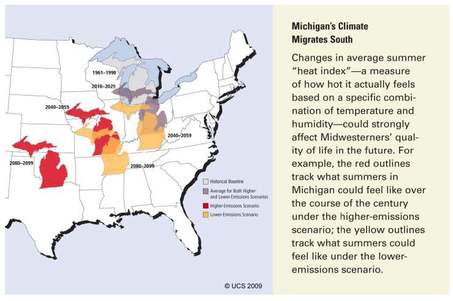|
The following are excerpts from an excellent blog post written by Bill Krasean on Michigan State University’s W.K. Kellogg Biological Station Long Term Ecological Research blog. Read the entire post here. "If computer models of changing climate are accurate — and they get better all the time — Michigan’s weather in less than a century may be similar to Oklahoma’s today.  Graphic from the Union of Concerned Scientists http://www.ucusa.org. Graphic from the Union of Concerned Scientists http://www.ucusa.org. "With little question summers will be hotter and there will be far fewer — if any — bitter cold spells in winter. Although predictions about precipitation are less reliable, there may be longer periods of drought and short, intense periods of heavy rain and snow. "That according to Dr. Perry Samson, professor of Atmospheric, Oceanic and Space Sciences at the University of Michigan and noted tornado chaser. Samson, who co-founded the Internet site wunderground.com, spoke July 10, 2012 at the Kellogg Biological Station symposium “Translating Science/Telling Stories: Agriculture, Water Quality & Changing the Climate Conservation. … "Two decades ago, when climate science was in its infancy, scientists were noting that the first signs of a global warming trend would first show up in polar regions. In the years since, summer ice cover in the Arctic has been shrinking, permafrost has been melting and other changes are confirming that prediction. Samson said that Arctic ice in summer could be gone within the lifetimes of many at the talk. "He said that the modest 3º C rise in average global temperatures in recent decades is trumped by a 12º C rise in polar temperatures. "Decreasing polar ice is one of several components of feedback mechanisms at work to raise global average temperatures, he said. As ice melts, less solar energy is reflected back into space and more absorbed by the dark water and land. Additionally, as heat-trapping levels of carbon dioxide continue to rise, ocean temperatures rise as does the amount of moisture in the atmosphere. "Oceans, which cover about three-fourths of the globe, are carbon sinks, meaning that a significant portion of the human-generated carbon dioxide is absorbed by the ocean and kept out of the atmosphere where it traps solar energy. But, Samson said, warmer ocean water is less efficient in absorbing carbon dioxide and more of the heat-trapping gas enters the atmosphere. … "One thing the models are predicting over the next century sounds somewhat ironic: More drought and more rainfall. “What that means,” he said, “is that there will be longer periods of drought and less frequent, but more intense rainfall, causing flooding.” And as temperatures rise and there is more moisture in the atmosphere, there likely will be more hurricanes, some of which threaten major cities along the southern U.S. coast, as well as major changes in global rainfall patterns. … "Samson said that even if all human carbon dioxide emissions ended today it would be 100 years before atmospheric conditions returned to what they are at present. The half-life of carbon dioxide in the atmosphere is 120 years and oceans are slower at responding to global temperature changes. 'If that’s the case, you may ask why bother to change our lifestyle,' he said. 'But there is value in making adjustments now for long-term benefits.'" Comments are closed.
|
Archives
February 2019
Categories |
 RSS Feed
RSS Feed
